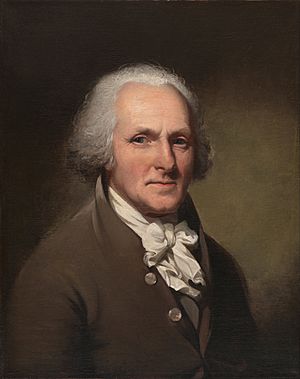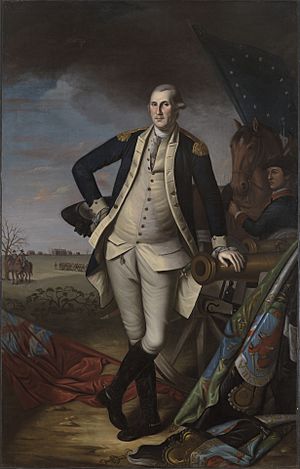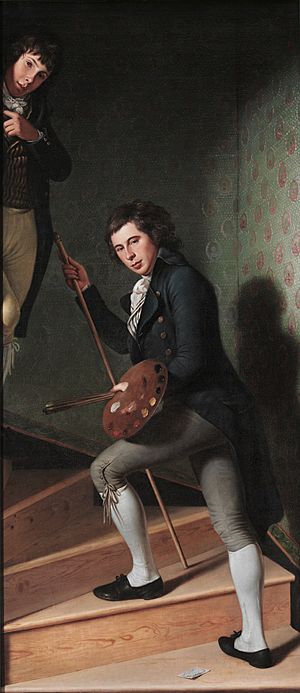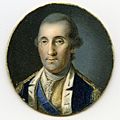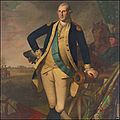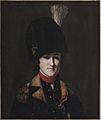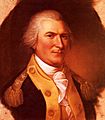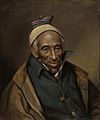Charles Willson Peale facts for kids
Quick facts for kids
Charles Willson Peale
|
|
|---|---|
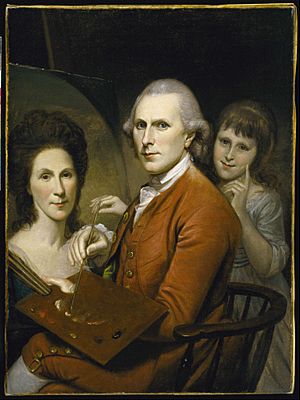
Charles Willson Peale, self-portrait, c. 1782–85 with portraits of his wife Rachel and his daughter Angelica
|
|
| Born | April 15, 1741 |
| Died | February 22, 1827 (aged 85) Philadelphia, Pennsylvania, United States
|
| Resting place | Saint Peter's Episcopal Churchyard, Philadelphia |
| Nationality | American |
| Known for | Painting |
Charles Willson Peale (April 15, 1741 – February 22, 1827) was a very talented American. He was a painter, a soldier, a scientist, and even an inventor! He is most famous for his portraits of important people from the American Revolution. He also started one of the first museums in the United States.
Contents
Early Life and Art Training
Charles Willson Peale was born in 1741 in Queen Anne's County, Maryland. He had a younger brother named James Peale, who also became an artist. When Charles was 14, he started learning to make saddles. Later, he tried fixing clocks and working with metals. These jobs did not work out well for him.
Then, he discovered his talent for painting. He was especially good at painting portraits of people. He learned from other artists like John Hesselius and John Singleton Copley. Friends helped him get enough money to travel to England. There, he studied painting for three years with a famous artist named Benjamin West. After returning to America, he taught his brother James how to paint.
Painting During the American Revolution
Peale was very excited about the new American government. In 1776, he moved to Philadelphia, which was the capital at the time. He painted portraits of many important Americans and visitors.
He also joined the fight for American independence. He became a captain in the Pennsylvania militia by 1776. He even painted small portraits of officers in the Continental Army while he was serving. Later, he made bigger versions of these paintings. He served in the Pennsylvania state government for a short time. After that, he focused on painting full-time again.
Peale painted many historical figures. These included Benjamin Franklin, John Hancock, and Thomas Jefferson. He is perhaps best known for his portraits of George Washington. Washington first posed for Peale in 1772. They had six more sittings after that. Peale used these sittings to create almost 60 portraits of Washington. In 2005, one of his paintings, Washington at Princeton (from 1779), sold for a record-breaking $21.3 million.
One of his most famous paintings is The Staircase Group (1795). It shows his sons, Raphaelle and Titian. The painting uses a special style called trompe l'oeil. This means it "fools the eye" into thinking the painting is real. It is now at the Philadelphia Museum of Art.
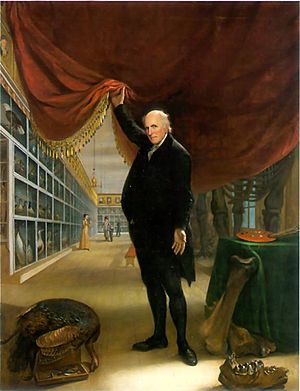
Peale's Museum
Charles Willson Peale loved natural history. He even organized the first scientific trip in the U.S. in 1801. He combined his interests by starting the Philadelphia Museum. It was later called Peale's American Museum. This museum had a wide variety of plants, animals, and old artifacts.
The museum had many birds that Peale collected himself. He even taught himself taxidermy to prepare them. He traded American birds with a museum in London for British birds. The Peale Museum was also the first to show a mastodon skeleton. Peale found these large bones in New York State. He worked with his son to put the huge skeleton together for everyone to see.
Displaying the "mammoth" (mastodon) bones was part of a big debate. Thomas Jefferson and Comte de Buffon argued about whether Europe or America had bigger animals. Jefferson used these "mammoths" as proof that America had amazing wildlife. Peale's way of putting together large skeletons in 3D was very new and got attention from Europe.
Peale's museum was also one of the first to use Linnaean taxonomy. This was a system for classifying living things. It made his museum different from others that just showed strange objects.
The museum moved several times. It was in important buildings like Independence Hall. However, the museum eventually closed. Peale could not get enough money from the government to keep it going. After he died, the museum's collection was sold off.
Family Life
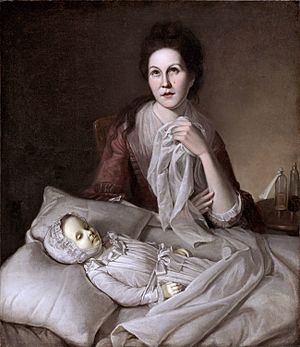
In 1762, Peale married Rachel Brewer (1744–1790). They had ten children. Many of their children were named after Peale's favorite artists. His sons included Raphaelle Peale (1774–1825), Rembrandt Peale (1778–1860), and Rubens Peale (1784–1865). Rembrandt also became a famous portrait painter and museum owner.
After Rachel passed away in 1790, Peale married Elizabeth de Peyster (d. 1804). They had six more children. One son, Franklin Peale, became the Chief Coiner at the Philadelphia Mint. Their youngest son, Titian Ramsay Peale (1799–1885), became an important naturalist and a pioneer in photography.
In 1804, Peale married Hannah More, a Quaker. She helped raise the younger children from his earlier marriages. Moses Williams, who grew up in the Peale household, was also trained in the arts. He later became a professional silhouette artist.
In 1810, Peale bought a farm in Germantown. He called it 'Belfield' and grew large gardens there. After Hannah died in 1821, Peale lived with his son Rubens. He sold Belfield in 1826. Charles Willson Peale died on February 22, 1827. He was buried at Saint Peter's Episcopal Church in Philadelphia.
Many Talents
Charles Willson Peale was a true Renaissance man. This means he was skilled in many different areas. Besides painting, he was good at carpentry, dentistry, and even shoemaking.
In 1802, he worked with John Isaac Hawkins to sell a device called a physiognotrace. This machine helped people draw portraits. Peale sent a drawing of it to Thomas Jefferson. Around 1804, Peale also got the rights to the polygraph. This machine could make a copy of a handwritten letter as you wrote it. Peale and Jefferson worked together to make this device even better.
Peale also wrote several books. These included An Essay on Building Wooden Bridges (1797). He named all his sons after artists or scientists. He taught them all how to paint. Three of them, Rembrandt, Raphaelle, and Titian, became famous artists themselves.
Legacy
- Three of his sons, Rembrandt Peale, Raphaelle Peale, and Titian Peale, became well-known artists.
- A cargo ship from World War II, the S.S. Charles Willson Peale, was named in his honor.
Images for kids
-
Nancy Hallam as Fidele in Shakespeare's Cymbeline (1771)
-
Miniature portrait of George Washington, Charles W. Peale (1775–76)
-
Portrait of George Washington, 1779
-
Miniature of John Laurens (1780)
-
Armand Tuffin de La Rouërie (1782)
-
Arthur St. Clair (1782)
-
William Moultrie, (1782)
-
Nathanael Greene (1783)
-
Benjamin Lincoln (1784)
-
Henry Knox (1784)
-
George Washington at Battle of Princeton (1784)
-
Washington, Lafayette & Tilghman at Yorktown (1784)
-
Timothy Matlack (c. 1790)
-
Thomas Jefferson (1791)
-
David Rittenhouse (1796)
-
Joseph Brant (1797)
-
James Wilkinson (1797)
-
James Mitchell Varnum, (1804)
-
Meriwether Lewis (1807)
-
William Clark (1810)
-
Yarrow Mamout (1819)
-
One of the polygraphs used by Thomas Jefferson, a portable version
See also
 In Spanish: Charles Willson Peale para niños
In Spanish: Charles Willson Peale para niños


